Tactics 101 075 – The Screen in Security Operations
SCREEN
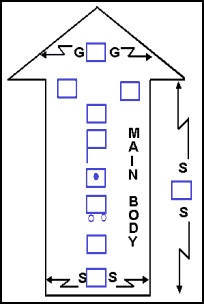
“THE PRINCIPLE OF SECURITY. The objective in battle being to destroy or paralyze the enemy’s fighting strength, consequently the side which can best secure itself against the action of its antagonist will stand the best chance of winning, for by saving its men and weapons, its organization and morale, it will augment its offensive power. Security is, therefore, a shield, not a lethal weapon.”

Major-General J.F.C. Fuller
{default}LAST MONTH
Our last article began a series of articles we will devote to security operations. We utilized the first article as a primer to get our audience up to speed on the basics of security operations. Our discussion focused on these areas: 1) The definition of security operations. 2) The types of security operations. 3) The key fundamentals of security operations. 4) Basic planning considerations of any security operation. With this background complete, we can now key in on the primary types of security operations.
THIS MONTH
This month’s article will focus on the first of the ‘Big 3’ in regards to the types of security operations you may execute – the screen. (In subsequent months, we will attack the guard and cover). In dissecting the screen, we will address several areas. First, we will provide a definition of the screen. Second, we will touch on the characteristics of the screen and how it is differentiated between the guard and cover. Third, we will address the phases of conducting a screen. Fourth, we will discuss the types of screens you can conduct. Finally, we will lay out some of the key graphical control measures you could utilize to command and control a screen operation. Lots to cover this month so – LET’S MOVE OUT!

Definition
In a screen operation, a unit is asked to gain and maintain surveillance; provide early warning to the main body of the higher unit they are assigned to; or may be required to impede, harass, or destroy enemy recon elements within their capability without being decisively engaged.
Let’s dissect some of the key components of this definition.
Gain and Maintain surveillance – It all begins with getting your eyes out at a location which enables you to observe and identify enemy actions.
Provide early warning – The primary role of a unit on a screen is to ensure the main body of the unit does not get surprised by the actions of its’ enemy. The unit conducting the screen, along with the higher headquarters will determine on the ground where the optimal location is to provide this early warning. Thus, early warning is obviously tied to time, but also tied to providing the main body the space it requires to react to any enemy initial actions.
May be required to impede, harass, or destroy enemy recon elements – The focus of the screen unit is not to destroy every enemy element it sees on its’ mission. It should not be equipped or organized to do this. As we have discussed, it is to observe and identify. However, if the tactical situation warrants; the screen force may be required to impede, harass or destroy enemy elements. The necessity is two-fold. First, is to aid in the screen forces’ own survival. Second, is to assist in providing early warning for the main body.
Without being decisively engaged – One of the cardinal rules of a unit conducting a screen is not to get decisively engaged. The major reason is that they will likely not possess the combat power to easily get out of jams. Becoming decisively engaged can lead to the main body maneuvering forces forward to assist (this is if indirect fires are not successful).
Characteristics of the Screen
There are several unique characteristics of the screen which differentiate it between the guard and cover. These include the following:
- The most commonly executed security mission.
- The least amount of internal protection for a force conducting a security mission.
- Should only engage the enemy in self-defense.
- Appropriate when a unit has extended flanks.
- Appropriate when gaps exist between units and can’t be totally secured.
- Commander simply wants early warning for his main body.
- Unit does not possess significant combat power to commit to security operations.
- Is purely defensive in nature.
Screen Key Concepts
Before we get much more in depth on screen operations; let’s address some of the key concepts that will continually surface in our discussion:
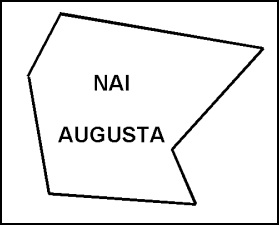
Named Area of Interest: In terms of screen operations; everything revolves around the Named Area of Interest (NAI). As a reminder from past articles, an NAI is “a point or area along an avenue of approach where you believe enemy activity is likely to occur. This activity or lack of activity will confirm or deny a particular enemy course of action.” In a screen mission, the screen force will almost always be given some NAIs to observe. These NAIs provide focus for the unit and should be in locations which will assist in providing early warning for the main body.
Screen Line: This is an extremely important control measure in the conduct of screen operations. The screen line is depicted as a phase line on the graphics. In the planning of a screen operation, it is first utilized as a mark for the screen force to maneuver to and recon to determine if this location is appropriate to observe from. The prime considerations in selecting this screen line are time and distance. These considerations impact on the ability of the screen force to provide early warning. Once the screen force decides where this location is, the phase line is formalized. Once formalized, this phase line also becomes the limit of advance for the screen force to maneuver to. In other words, the screen force cannot maneuver past this location unless approved by their higher headquarters.

Observation Posts: In our last article, we touched on Observation Posts (OP). Within screen operations, the use of OPs is the method in which a force observes and identifies the information they are tasked by their commander. As a real simple definition, an OP is a location from which observations are made.
Phases of the Screen
It wouldn’t be an operation unless it had phases! Well, when a unit conducts a screen there is a basic flow of how the operation should shake out. Let’s discuss this flow below.
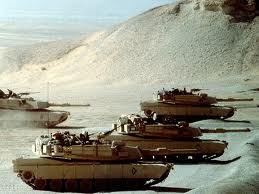
Phase 1 – Maneuver to the Screen Line
As the saying goes, “you must arrive alive.” Because the situation is so fluid and unclear at this point of the operation, the maneuver to the screen line is a challenging mission in itself. As in all things tactics you must understand yourself, the enemy, and the terrain in planning, preparing and executing your maneuver to the screen line. In some cases, the current tactical situation may dictate that the screen line will be located very near where the unit presently sits. However, in other circumstances maneuver (sometimes at significant distances) will be required. In that case, there are three options that a commander will usually consider if maneuver is necessary. These are: 1) The Tactical Road March 2) The Movement to Contact 3) The Zone Reconnaissance. Let’s discuss when each of these would be the most feasible option.
1) The Tactical Road March – When you need to occupy a screen line quickly and enemy contact is highly unlikely; the tactical road march is the optimal option. Essentially the tactical road march is a start point (from the present location) to a release point (where the unit will then occupy their screen line). At first glance, some may insinuate that a tactical road march is ducks in a row, high diddle diddle up the middle. This would be a wrong assumption. A tactical road march is exactly that – tactical. Those units that do not put a premium on security and plan for the what-ifs will eventually suffer the consequences. (We will highlight the tactical road march in a future article).
2) The Movement to Contact – When the enemy situation is a little more unclear, the screen force may conduct a movement to contact. Obviously, this technique is a little slower than the tactical road march. However, with this comes more security for the screen force as a whole. Within the movement to contact, the force will execute this from their current location to the screen line.
3) Zone Reconnaissance – If a unit has sufficient time, the zone reconnaissance is the preferred technique. In executing a zone reconnaissance, the unit is really conducting a two-fer. First, the screen force conducts the zone recon from their initial location to the screen line. As a review from our previous article on reconnassiance, (http://armchairgeneral.com/tactics-101-070-reconnaisance-part-1-the-foundations.htm) below is a quick definition of a zone recon:
Zone – A zone recon is focused on obtaining information (on the enemy or terrain) on a particular zone dictated by the commander. The zone will be articulated by boundaries. This zone could contain a route or routes and an area/areas. Thus, it is the encompassing of all the forms of recon.
A commander will decide a zone recon is needed when he requires more info on a zone in which he anticipates maneuvering in the future. At the present time, the commander has little information on the enemy and the terrain. Thus, the requirement for the zone recon.
Once the unit has completed the zone recon and has arrived at the proposed screen line, it will then begin the task of occupying the screen line. Executing the zone recon is certainly the most time consuming of the three techniques. However, there are several benefits. First, the unit as a whole collects information on the terrain and the enemy forward of their present location. This is information they do not presently have. Second, it is a very secure method of movement

Phase 2 – Occupy Screen Line
The unit has maneuvered itself to the screen line. If all as gone well, the force is mentally and physically prepared to execute the screen. If things have not gone as well, the ability of the force to conduct the screen will be diminished. In either case, it is time for the force to occupy the screen line. This task cannot be done haphazardly. There are many things that must be accomplished before the force actually occupies the screen line. These tasks are:
• You already have a templated a location for the screen line. This may have been determined by an earlier recon of the area. However, in most cases this recon likely did not occur. Thus, the first thing that most be achieved is a quick, but detailed reconnaissance of the area by the screen force leadership. The obvious requirement in selecting these locations is ensuring they can observe what the commander wants the screen force to observe. Additionally, it should provide adequate cover and concealment for the screen force.
• Once locations are decided upon, it is time to occupy them. This occupation cannot be done hastily and sloppily. This only can bring disastrous results. Units must plan their occupation of the screen line. Forces will normally maneuver from a cover and concealed position to their designated locations on the screen line. This positions can be dismounted OPs, mounted OPs, and of course a mixture. In occupying the screen line, you may also emplace various types of radars and sensors to provide early warning of the enemy. These assets were discussed in our previous article on reconnaissance: http://armchairgeneral.com/tactics-101-070-reconnaisance-part-1-the-foundations.htm
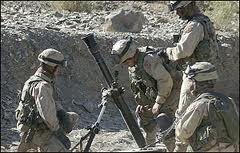
• Upon occupation of the screen line, forces must also conduct the following:
o Finalize your indirect fire plan. Because a screen force generally does not possess significant fire power; the use of indirect fire is option number one when trouble occurs. Thus, it is critical the screen force has a well-developed indirect fire plan. This plan obviously includes assets from higher headquarters (field artillery) and may also include a section of mortars attached for responsive fires.
o Finalize your direct fire plan. Although you do not want to get in a direct fire fight with the enemy; you must plan for it. The commander of the screen force must have a direct fire plan that includes essentials such sectors, maximum engagement lines, and engagement areas. Neglect this planning at your own risk.
o Although the screen force will not have significant logistical assets; they must be located where they can support the screen force. This can be a challenge when the screen line is extended in width and/or depth. If the screen force is a long distance away from the main body; air evacuation of any casualties must be planned.
o The command and control of the screen force can be a challenge. The commander of the screen force must ensure he is positioned to understand and influence operations on the ground. He must also ensure he has a solid communications (with redundant means) plan in place. This plan is two-fold. First, it enables him to receive timely and accurate reports from his subordinates. Second, it enables him to send these reports (after he synthesizes them) to his higher headquarters.
o One of the critical tasks to occupying the screen line is ensuring you have conducted all necessary coordination (especially on your flanks). In many operations, there will be other units (from other units) conducting operations on your flanks. You must ensure contact is made with these units for two primary reasons. First, to determine if any gaps exist between the operations of the units. These gaps could be exploited by the enemy. If gaps do exist, it should be reported to a higher headquarters to ensure they are aware and to act on if necessary. Second, operations in the security are very fluid and can get confusing. Units must ensure they understand who their friendlies are and what they are doing. If they don’t, this could very well lead to friendly fire incidents on the battlefield.

Phase 3 – Surveillance and Counter-Reconnaissance
Occupation is complete and it is now time to observe and provide early warning for the main body. The screen force will conduct this surveillance by a variety of means. The primary means (as addressed earlier) is through the use of OPs. These can be augmented by various assets including different types of radars and sensors. Certainly, in this case technology can be a huge benefit for the force. Another consideration in surveillance is to fill those gaps that we have discussed earlier in the article. One of the ways to mitigate these gaps is to conduct patrols in these areas.
In conducting surveillance the obvious driver is the NAIs assigned to the screen force to observe. Since this is so critical, the screen force must organize and locate its assets keying on the NAIs. Two key principles (which we have discussed in our recon series) are redundancy and cuing. Let’s review each since they are so important in a screen.
Redundancy – If information is clearly vital to assisting a commander in making a decision you must have redundant assets assigned to collect. In definition, redundancy is utilizing two or more like assets to collect information against the same requirement
Cuing – When you conduct cueing, you first utilize one asset to collect fairly general information in a certain area. If certain information is found this then triggers (cues) another asset to go into the area and collect more specific information. Cueing is usually conducted when you have limited ground R&S assets (which are usually the case).
Counter-Reconnaissance – We will delve into this topic far more in an upcoming article. As the name suggests, in counter-recon you are striving to ensure the enemy does not have success in his recon operations. In traditional counter-recon this means destroying the enemy’s recon assets. To achieve this, you usually divide the force into hunters and killers. In other words, someone finds/observes the enemy recon assets and someone else kills them. In a screen operation, the screen force is generally not manned/equipped to hunt and kill. Thus, based on their mission they are clearly suited to observe enemy recon and let someone else do the killing. This coordination and handoff as you can expect is a real challenge (again, we will address this in a future article). This must all be worked out before the screen force begins their operation. As always, the screen force must also worst-case it and have a plan to both hunt and kill.
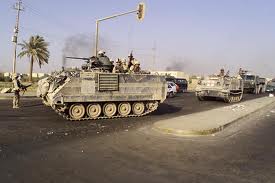
Phase 4 – Displace/Maintain Contact
One of most difficult phases of the screen mission is for the unit to displace while still maintaining contact with the enemy. A unit which completely breaks contact from the enemy is certainly putting the main body in a precarious position. The old rule almost always applies, “Once you gain contact, maintain contact.” This is easier said than done if the enemy is breathing down your neck.
So how do you achieve this? The best way to look at this is to approach it as a retrograde operation. (http://armchairgeneral.com/tactics-101-035-the-withdrawal.htm)
In doing this, the key is prior planning. During the initial planning of the mission, it is imperative you look at the terrain to determine locations where you may fall back to. Consequently, graphics must be developed that include phase lines which elements of the screen force can fall back to and potential OP locations.
In execution, the screen force will echelon their fallback in order to maintain contact. Typically, a portion of the screen force will fall back to the preplanned screen line. Once they are set, the forces left at the original screen line will fall back past this force to another preplanned location. This ‘bounding’ continues until forces are near the main body. Once this is completed, the screen force can begin Phase 5 – The Passage of Lines.
Before leaving this phase, a few things to remember:
- Contact does not necessarily have to be eyes on. Well-placed and dependable radars and sensors can be utilized to maintain contact when Soldiers eyes are not feasible.
- During displacement, the best friend of the screen force can be indirect fires. As discussed earlier, a screen force normally does not possess significant combat power. Thus, becoming decisively engaged is not a good thing. To get out of trouble, indirect fires (accurate and above all, responsive) are the weapon of choice.
- With moving pieces maneuvering around the battlefield it is imperative that all forces know what is taking place. During displacement there must be constant communications between the screen force and the main body. Lack of communication can lead to bad things.
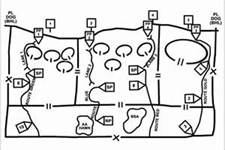
Rearward Passage of Lines Graphics
Phase 5 – Passage of Lines
The mission is not complete until you have successfully passed through the main body. Perhaps, of all the phases the passage of lines can be the most challenging. It seems that chaos is running rampant around the battlefield during any passage of lines. The screen force normally has several challenges when it conducts its passage. First, the enemy is normally not far away. Second, conducting a screen is exhausting. Consequently, the screen force is mentally and physically tired. Third, it seems that the passage is always occurring during limited visibility.
Whatever the case, the goal of the passage is to quickly, without incident, pass the screen force through the main body to a location in the rear area. There, the screen force can refit, refuel, and rearm itself. In this location, the screen force can then prepare for its’ next mission. Again, you cannot expect a lot out of the screen force anytime soon. Let them take care of business and then give them a new purpose and task.
There are several actions which assist in making the passage as smooth as possible. These include: 1) Reconnaissance of the location which the screen force will occupy. 2) An advance party to meet the screen force at the location. 3) A logistical package waiting at the location for the screen force to utilize. 4) A guide vehicle to meet the screen force and escort them to the location. 5) Communications throughout the main body informing them that the screen force is passing through.
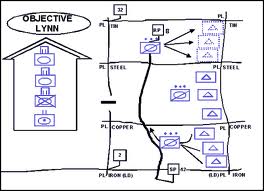
Moving Screen
Types of Screen Operations
There are two basic types of screens a unit can execute. These are the stationary screen and the moving screen. Let’s address each and lay out their particulars.
Stationary Screen – This type of screen is utilized when the main body is itself – stationary. This usually means that the main body is either in preparation for an attack or is preparing a defense. In fact, the majority of this article was written with the stationary screen as the basis. Consequently, we will not spend any further time discussing the stationary screen.
Moving Screen – This type of screen is normally utilized when the force is executing maneuver. Based on the situation, you will place a screen force on the main body flank or flanks and perhaps the rear of the formation. Again, the commander will decide where in his formation he requires screens.
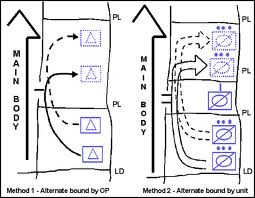
Of course there are two significant challenges for the force conducting the moving screen. The first is operating at a distance that provides the main body sufficient early warning of enemy actions. Second, is the ability of the screen force to maneuver with the main body and continue to conduct the screen operation. In order to assist in achieving this, the screen force has several techniques they may utilize. Let’s address these below:
Continuous Maneuver – As you can surmise from the title, in this technique the entire screen force is maneuvering at the same time. This technique is generally utilized when the main body is maneuvering very quickly and enemy contact is highly unlikely. This technique is certainly the least secure of the ones available to a unit. It does keep the unit together throughout and normally makes them available for another mission almost immediately after the screen is complete.
Alternate Bounds by OPs – The best way to ensure surveillance during movement is to bound by OPs. In this method, the screen force will occupy OPs throughout the main body’s maneuver. As the main body maneuvers forward, OPs will position themselves to provide the early warning needed for the main body. This technique would be utilized if you believe enemy contact is possible and you desire the most surveillance possible from the screen force. Certainly, the bounding of OPs can be a time consuming process. It also requires a skilled screen force who can set-up and displace quickly. It must also have leadership that has a superb understanding of when and where to place the OPs. If executed correctly, this is an extremely secure technique and one that provides outstanding surveillance throughout the main body’s maneuver.
Alternate Bounds by Units – Another method available to a commander is to bound by units. Let’s use a company for our example. If a company (no matter the flavor) was given the screen mission, it would bound by platoons. Thus, as the main body maneuvered; the screen force would continually bound by platoons to provide the screen. Like the method above; you would utilize the technique when enemy contact is possible. However, unlike the above; the main body is likely to be maneuvering a little faster and the commander does not want maximum surveillance (which OPs provide). There are several advantages to this technique. First, it is far easier to bound by units vice OPs. Consequently, if the main body is maneuvering at a pretty good pace; unit bounding may be the preferred method. Second, this technique does afford good surveillance for the unit. Third, bounding as smaller units keeps unit integrity. The one disadvantage of the technique is that it can lead to some gaps in coverage when the bounding is not properly synchronized.
Successive Bounds – The last technique available is successive bounds by the screen force. In this method, the screen force in its’ entirety, bounds from position to position to provide the screen for the main body. You will normally utilize this technique when the main body is making frequent halts in their maneuver. This bounding by the entire unit clearly takes the most time of all the methods. This bounding can also mean that the unit as a whole is less secure while maneuvering. Additionally, it can lead to some temporary gaps in coverage while bounding. However, when set this is the most secure of the methods and provides the best surveillance.
Which method to use? It all depends, as always, on the conditions (friendly, enemy, and terrain and weather)!
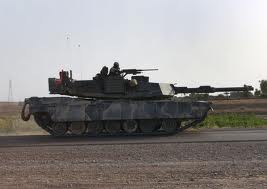
Control Measures
In every tactical mission, you must develop clearly understandable and effective control measures to set the conditions for success. It is no different in executing a screen operation. Below we will provide you a snapshot of the typical control measures utilized in the screen. We will follow the example with an explanation of each of the measures.
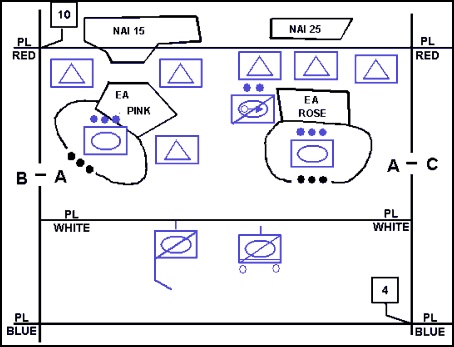
- As we discussed several times, the screen force must be given areas to observe. The NAIs designate these areas.
- Phase lines initially define the forward edge of the screen line (in this case – PL RED). Later they are utilized to define future fall back screen lines (PLs WHITE and BLUE).
- Observation Posts are generally utilized to place assets in locations where they can observe NAIs. These OPs are represented by the triangles. For sake of argument, these are dismounted OPs.
- Because these are dismounted OPs, we must designate areas for the vehicles to locate. To facilitate potential contingencies, we have placed these armor platoons in battle positions focused on Engagement Areas PINK and ROSE.
- As we addressed earlier in the article, a screen force does not possess significant combat power. To augment this force, we have assigned a mortar section and positioned them to the left of EA ROSE. They will support the OPs initially and reposition if the OPs reposition.
- Command and control and logistics are critical to screen operations. In the above depiction, we have placed the command and control and logistical nodes near PL WHITE.
- Finally, coordination is imperative in a screen. To facilitate this, we have placed coordination points (4 and 10) to aid in flank coordination.

This is pretty basic graphics. It would provide sufficient measures to conduct the screen.
REVIEW
To most, executing a screen is a pretty elementary task. In fact, in tactics it is a term which is thrown around commonly. However, this article should have highlighted that conducting a screen is far more difficult. It takes quality planning and preparation to set the conditions for a successful screen. It also takes a good unit to execute a screen. Next time you hear the term; remember just how challenging a screen operation is.
NEXT MONTH
Our next article will address the second of the primary security operations – guard. In a guard, the complexity of the operation is a notch above that of the screen. We will address these complexities. In dissecting a guard operation, we will attack it the same way we did with the screen. See you next month!
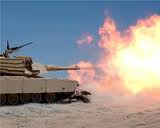


Pure gold. I am a Cavalry Troop Commander and just found an excellent resource, outside of Army field manuals, to teach coach and mentor my Soldiers on security operations. Not to mention brushing up on the doctrine myself. Thanks for posting such a great article.
LANCE C. RAE
CPT, AR
Commanding
Being a new leader in a scout platoon and having to teach the soldiers critical information pertaining to being a scout, this is one of the best, if not THE best sources I have found outside of Military articles and FM’s on Screen Operations. Its simple to understand, its broken down to the exact detail. Thanks for posting this. Love it!